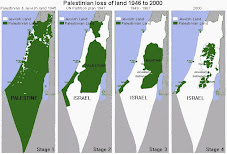 Israeli soldiers beat Iyad Bornat, one of the Bi'lin nonviolent movement leaders
Israeli soldiers beat Iyad Bornat, one of the Bi'lin nonviolent movement leadersUK Guardian - Neve Gordon
Palestinians have a long history of nonviolent resistance but Israel has continuously deployed methods to destroy it
Why," I have often been asked, "haven't the Palestinians established a peace movement like the Israeli Peace Now?"
The question itself is problematic, being based on many erroneous assumptions, such as the notion that there is symmetry between the two sides and that Peace Now has been a politically effective movement. Most important, though, is the false supposition that Palestinians have indeed failed to create a pro-peace popular movement.
In September 1967 – three months after the decisive war in which the West Bank, Gaza Strip and East Jerusalem were occupied – Palestinian leaders decided to launch a campaign against the introduction of new Israeli textbooks in Palestinian schools. They did not initiate terrorist attacks, as the prevailing narratives about Palestinian opposition would have one believe, but rather the Palestinian dissidents adopted Mahatma Gandhi-style methods and declared a general school strike: teachers did not show up for work, children took to the streets to protest against the occupation and many shopkeepers closed shop.
Israel's response to that first strike was immediate and severe: it issued military orders categorising all forms of resistance as insurgency – including protests and political meetings, raising flags or other national symbols, publishing or distributing articles or pictures with political connotations, and even singing or listening to nationalist songs.
Moreover, it quickly deployed security forces to suppress opposition, launching a punitive campaign in Nablus, where the strike's leaders resided. As Major General Shlomo Gazit, the co-ordinator of activities in the occupied territories at the time, points out in his book The Carrot and the Stick, the message Israel wanted to convey was clear: any act of resistance would result in a disproportionate response, which would make the population suffer to such a degree that resistance would appear pointless.
After a few weeks of nightly curfews, cutting off telephone lines, detaining leaders, and increasing the level of harassment, Israel managed to break the strike.
While much water has passed under the bridge since that first attempt to resist using "civil disobedience" tactics, over the past five decades Palestinians have continuously deployed nonviolent forms of opposition to challenge the occupation. Israel, on the other hand, has, used violent measures to undermine all such efforts.
It is often forgotten that even the second intifada, which turned out to be extremely violent, began as a popular nonviolent uprising. Haaretz journalist Akiva Eldar revealed several years later that the top Israeli security echelons had decided to "fan the flames" during the uprising's first weeks. He cites Amos Malka, the military general in charge of intelligence at the time, saying that during the second intifada's first month, when it was still mostly characterised by nonviolent popular protests, the military fired 1.3m bullets in the West Bank and Gaza. The idea was to intensify the levels of violence, thinking that this would lead to a swift and decisive military victory and the successful suppression of the rebellion. And indeed the uprising and its suppression turned out to be extremely violent.
But over the past five years, Palestinians from scores of villages and towns such as Bil'in and Jayyous have developed new forms of pro-peace resistance that have attracted the attention of the international community... Israel, in turn, decided to find a way to end the protests once and for all and has begun a well-orchestrated campaign that targets the local leaders of such resistance.
One such leader is Abdallah Abu Rahmah, a high school teacher and the co-ordinator of Bil'in's Popular Committee Against the Wall, is one of many Palestinians who was on the military's wanted list. At 2am on 10 December (international Human Rights Day), nine military vehicles surrounded his home. Israeli soldiers broke the door down, and after allowing him to say goodbye to his wife Majida and three young children, blindfolded him and took him into custody. ...
The day before Abu Ramah was arrested, the Israeli military carried out a co-ordinated operation in the Nablus region, raiding houses of targeted grassroots activists who have been fighting against human rights abuses. Wa'el al-Faqeeh Abu as-Sabe, 45, is one of the nine people arrested. He was taken from his home at 1am and, like Abu Ramah, is being charged with incitement. Mayasar Itiany, who is known for her work with the Nablus Women's Union and is a campaigner for prisoners' rights was also taken into custody as was Mussa Salama, who is active in the Labour Committee of Medical Relief for Workers. Even Jamal Juma, the director of an NGO called Stop the Wall, is now behind bars.
Targeted night arrests of community leaders have become common practice across the West Bank... Adeeb Abu Rahmah, a prominent activist who has been held in detention for almost five months and is under threat of being imprisoned for up to 14 months.
.... The objective is to put an end to the pro-peace popular resistance in the villages and to crush, once and for all, the Palestinian peace movement... Full story







